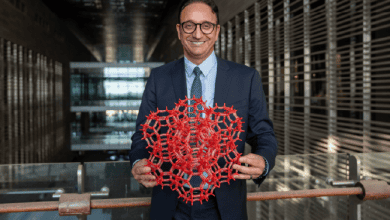A Decades Long Passion in Surface Chemistry

منذ طفولته في تونس، ظهر اهتمام محمد الهادي المطوسي بالفيزياء والكيمياء؛ في البداية، وفي أثناء محاولته فهم كيف يعمل المصباح الكهربائي، أو كيف يتشكل السراب في الأيام المشمسة الحارة. ولكن هذه التأملات اليافعة، لم تكن كافية لإرضائه، فتوجه لإشباع فضوله الواسع نحو دراسة الفيزياء في جامعة تونس المنار، قبل أن يحصل على الدكتوراه في الكيمياء الفيزيائية من جامعة بيير وماري كوري في العام 1987.
ومع ذلك، فإن الوقت الذي قضاه المطوسي، بوصفه عالماً زائراً في معهد ماساتشوستس للتكنولوجيا في منتصف تسعينات القرن العشرين، هو الذي ساعد في توجيهه نحو تخصص في الفيزياء والكيمياء، معروف باسم «النقاط الكمّيّة» Quantum dots، لم يكن يُعرَف عنه الكثير في ذلك الوقت. هذا الشغف الذي استمر على مدى عقود، لم يكن وراء نيل المطوسي جائزة الكويت للعام 2022 من مؤسسة الكويت للتقدم العلمي فقط، بل أيضاً جائزة الجمعية الكيميائية الأمريكية للعام 2024 في كيمياء الأسطح.
“I got into the colloidal quantum dot area after sitting through a talk by [2023 Nobel Prize in Chemistry winner Moungi Bawendi], when he was very young (and I was very young, too),” Mattoussi said. “Halfway through the talk, I thought, ‘I can do this. This is something to which I can contribute.’”
The excitement around quantum dots (QDs)—also known as semiconductor nanocrystals—derives from the fact that, at incredibly small scales, these particles exhibit quantum effects. These characteristics can be used, for example, to create LEDs or solar cells that operate far more efficiently. Mattoussi’s background in surface chemistry focuses largely on how QDs interface with biological systems. In a 2008 paper, “Potential Clinical Applications of Quantum Dots,” Mattoussi explored uses that range from cell labeling to biosensing to in vivo imaging to diagnostics.
While the recent Nobel Prize in Chemistry awarded to Moungi Bawendi, Louis Brus, and Alexei Ekimov has placed quantum dots squarely in the scientific spotlight, their development has taken a lifetime. Mattoussi recalls conferences from three decades ago, during the infancy of QD research, where the particles would warrant a single symposium attended by just a handful of specialists.
“In science, progress is like a snail. Considering an experiment, doing it, collecting the data, figuring out what it means, understanding it. But in science, you have to be methodical—and sometimes methodical is slow,” Mattoussi said. “But that just means that it has been done properly and thoughtfully. It took thirty years for the community to sort things out.”
A common struggle for most laypeople in understanding quantum dots is wrapping their heads around their relative size. In his 2020 paper, “Compact, ‘Clickable’ Quantum Dots Photoligated with Multifunctional Zwitterionic Polymers for Immunofluorescence and In Vivo Imaging,” Mattoussi and his colleagues inserted fluorescent quantum dots into fruit fly embryos, which measure barely half a millimeter wide. Quantum dots, however, are an incredible 2-10 nanometers—roughly 10-50 atoms—in diameter. If these infinitesimal insect embryos were scaled up to the size of a football pitch, an equally enlarged quantum dot would still only be as wide as a single human hair.
One lingering research question around quantum dots concerns their potential cytotoxicity—the detrimental impacts that QDs may have on living tissue, given that they are built from toxic elements such as cadmium or tellurium. However, Mattoussi, who leads the Mattoussi Lab at Florida State University, where he has been a professor in the Department of Chemistry and Biochemistry since 2009, has been instrumental in navigating this challenge. “What's interesting is that quite often, people think that because something has certain elements—like cadmium or selenium—it will be toxic,” Mattoussi said. “But for quantum dots, according to him, it’s all about surface functionalization; the coating.”
“Remember that these nanocrystals are essentially chunks of metal that would be unhappy to be anywhere. It’s what we put on the surface, the capping ligands—bifunctional molecules or polymers—that sometimes do more than half the job. They passivate the electronic properties of the core,” Mattoussi explained. “If you design these nanocolloids in a certain way, the surface ligands bind strongly while also providing affinity to the surrounding medium, allowing them to be placed in organic and/or aqueous solutions. You can reduce toxicity to essentially nothing by manipulating this surface coating. The more colloidally stable the nanocrystals are, the better the system works.”
Even after working on the subject for decades, Mattoussi remains excited about the incredibly fertile future awaiting his field—particularly ongoing investigations into N-heterocyclic carbenes (molecular ligands with a strong affinity for metals), perovskite nanocrystals (a subclass of semiconductor nanocrystals distinct from quantum dots), and the use of quantum dots in MRI contrast agents. “Eventually, we’ll probably try to make a dual-mode fluorescent magnetic or plasmonic material where you have a core with certain physical properties and the MRI contrast agent on the surface for MRI detection,” Mattoussi said.
Perhaps more than anything, Mattoussi continues to relish the thrill of exploration. The most rewarding aspect of his scientific field is the constant learning—nonstop, every day. It makes him feel young. “Maybe you’ve been working in an area for twenty years, and you think you know it all. No,” Mattoussi said. “You always find yourself faced with something unfamiliar, and you have to slowly stick your nose in the sand and just think about it. That is something that never dies. It’s really amazing.”
By Jonathan Feakins




